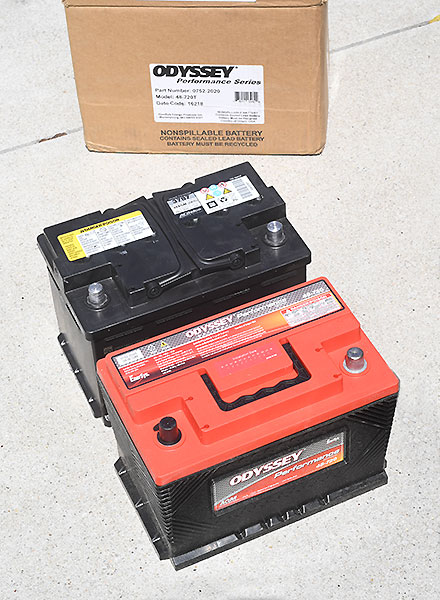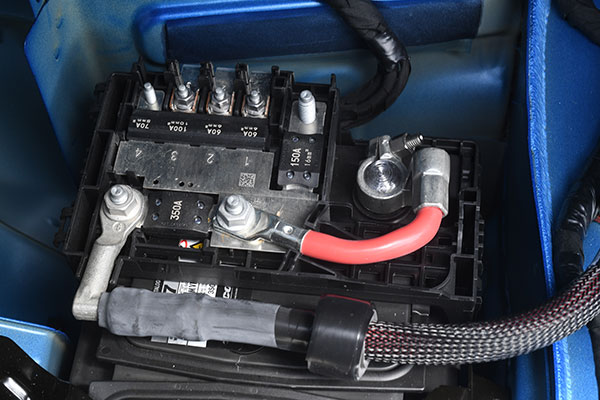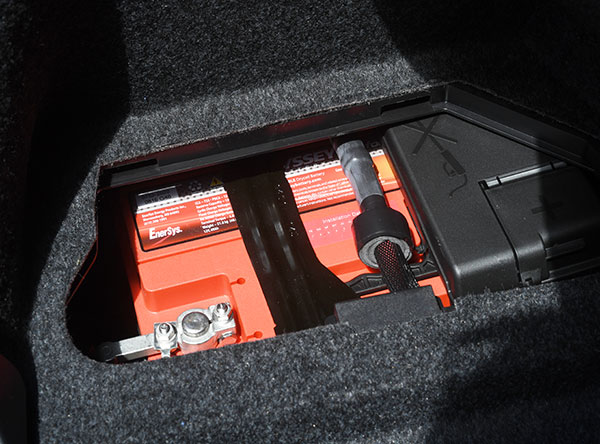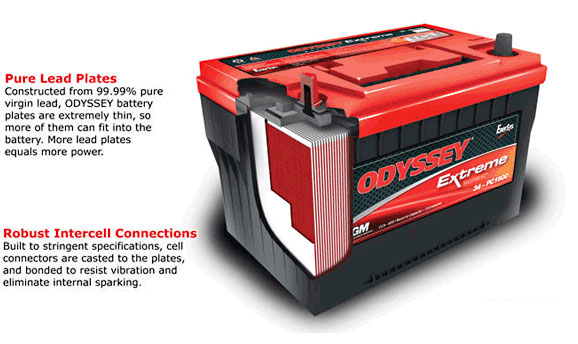Summary
In last 15 years, one reason I’ve become a fan of Odysseys is their high pulse cranking current output. “Pulse hot cranking amps” (PHCA) is not the same as “cold cranking amps” (CCA). A PHCA rating test simulates very high current draw for five seconds while the engine is cranked during the starting sequence. The ATS-V’s LF4 twin-turbo V6 has a fairly high compression ratio and the battery is in the back of the car at the end of a long cable run. Both those characteristics demand a battery capable of high pulse cranking current.
by Hib Halverson
At the Cadillac V-Net, one of the Torque Network family of web sites, when we put the “Blue BMW Buster,” our 2016 ATS-V six-speed in service, I began to think about an Odyssey Extreme Battery for the car. We have them in other Torque Network’s test cars and they have been great products. When we contacted EnerSys, its Specialty Marketing Manager, Alan Kohler, advised that the Extreme series doesn’t cover any Cadillac ATS. Kohler went on to say that Odyssey’s other sub-brand, the Performance series, offers a battery (PN 48-720) which matches the ATS-V’s stock, ACDelco 48AGM’s dimensions. The Odyssey Performance Battery is, also, just a scosh lighter, at 48-pounds. vs the ACD’s 49-lbs. but is more powerful.
An Odyssey Battery uses the “absorbent glass matt” (AGM) design, meaning there is no free sulfuric acid inside it. The acid is absorbed by and held in the glass mat separators which, also, keep the positive and negative plates apart. Due to the AGM design, Odysseys can be mounted on their sides or ends, just not upside-down. There is, also, a cost advantage. Since, an Odyssey has no free acid inside, it is covered under the US Department of Transportation unregulated “wet nonspillable electric storage batteries” and International Air Transport Association (IATA) “unrestricted air shipments” classifications. Odysseys may be shipped worry-free and at less expense and that reduces cost to consumers.

The stock Delco and the Odyssey Performance Battery have the same measurements. No mods are necessary to fit the Odyssey into the ATS-V’s battery location. Image: Author.
Odysseys use 99.99% pure or “virgin” lead for their plates. Pure lead plates can be made thinner, so Odysseys can have more of them. More plates mean more surface area and that means more power. Most consumer grade batteries use lead alloy which, when used in battery plates, requires the plates be thicker. Another Odyssey advantage is its traditional rectangular volume geometry rather than the cylindrical cells used by the Optima battery. Just that better use of space results in 15% more plate area and that means still more power for starting.

This little drawing is big-time revealing. It shows all the wasted space inside the Odyssey Battery’s main competitor. Image: EnerSys.
In continued email traffic with with Alan Kohler, we learned there are few differences between Odyssey’s Performance and Extreme lines, but for a street performance duty cycle, they do not compromise performance. The main variations are: 1) a case made of polypropylene rather than polycarbonate, 2) solid lead instead of tin-coated brass terminal posts and 3) “though-the-wall” rather than “over-the-wall” lead, top connectors. I asked Koler about the vent hose which connects to an ATS-V’s stock battery. He told us “Odyssey batteries do not require a venting system and therefore the 48-720 does not have a connection for the hose. As long as the battery is not installed in a gastight enclosure, no special venting arrangements are necessary for any Odyssey battery.”
In the last 15 years, one reason I’ve become a fan of Odysseys is their high pulse cranking current output. “Pulse hot cranking amps” (PHCA) is not the same as “cold cranking amps” (CCA). A PHCA rating test simulates very high current draw for five seconds while the engine is cranked during the starting sequence. The ATS-V’s LF4 twin-turbo V6 has a fairly high compression ratio and the battery is in the back of the car at the end of a long cable run. Both those characteristics demand a battery capable of high pulse cranking current. EnerSys doesn’t put much faith in CCA rating which is derived from a test discharge at 0ºF for 30 seconds. Unless the user is planning to actually discharge the battery that long at 0ºF, the CCA rating is meaningless. What is of paramount importance in an engine cranking application is the maximum current flow a battery can deliver for 3-5 seconds–that pulse cranking–to get that engine turning rapidly. Because of its high PHCA an Odyssey will outperform a much larger stock battery. ACDelco does not rate its products with a pulse hot cranking amps test. The PHCA rating of the Odyssey 48-720 is 1250-amps for five-seconds. If that won’t start an ATS-V, nothing will.
Another advantage of Odyssey Batteries is they are more tolerant of “deep cycles” than conventional batteries. Deep cycling is where you run the battery very low or dead, then fully recharge it. Most consumer-grade batteries suffer shorter service life if they are frequently deep-cycled. The Odyssey PC1200MJT in a Corvette Z06 which our sister web site, the Corvette Action Center, has in its fleet has performed quite well so far, in spite my inadvertently deep-cycling it a number of times. EnerSys states that its batteries can withstand 400 charge-discharge cycles to 80% depth of discharge.
So, how does the Odyssey Performance series 48-720 work in the real world? We’ve run it in an ATS-V for a couple of months and have observed it to be compatible with the ATS-Vs sophisticated, body-computer-controlled charging system. It is our belief that not all aftermarket batteries may support that system’s enhanced control over battery and charge system voltage. During the short period we have had the Odyssey Performance Battery in service, we’ve noted no unusual starting behavior and slightly higher cranking rpm. Odysseys are shipped fully charged, so, unless you keep it on the shelf for several years prior to installation; you can take it out of the box, put it in your V, then start-up and go.
The battery installation procedure is a bit difficult, but that’s not the fault of anything EnerSys does. It’s a Cadillac ATS issue. The battery is in the trunk, sandwiched between the driver-side rear quarter panel and the trunk interior trim. Changing it requires partial disassembly of the trunk trim. Required, is a trim removal tool designed to “pop-loose” those plastic “rivets” GM loves to use. Such tools are available from a variety of sources and we got ours from the Eastwood Company. First, remove the trunk floor panel. Then, remove the hard plastic trim at the back of the trunk. It’s held in place with Torx bolts which, also, retain the two trunk tie-down rings. Next, remove the rivets holding the trunk’s roof panel and pull out that piece. Finally remove the rivets holding the rear section of the trunk’s left side interior trim and fold that part away from the battery.

This is the Cadillac battery fuse block. To remove it, you disconnect the short cable from the battery positive post, release the two latches, then fold it back over the adjacent trunk floor. Image: Author.
With the trim out of the way and the battery exposed, first, remove the negative cable. The positive battery cable goes through a “battery fuse block”, common on newer Cadillacs, and then to the positive post. Disconnect the short cable to the battery’s positive post, then unlatch the fuse block, from the battery. Fold the cable and fuse block back and over the of the trunk floor. The rest of the process is easy. Remove the two battery hold-downs, then lift the battery out and put the Odyssey in its place. Both the Delco and the Odyssey have integral handles which make the lifting process easy. Reinstall the hold downs, fold the battery fuse block back over the top of the Odyssey and tighten the positive battery cable. The top edge of the Odyssey’s case will not accept the fuse block latches, but the fuse block will stay in place on the battery because: 1) the positive cable is clamped on its post and 2) once the trim pieces are replaced, they will, also, keep the fuse block from moving. As an extra measure, we used a black zip tie to further immobilize the fuse block.
Replace all the trim and you’re done.

Once all the trunk trim is back in place with only the battery access panel removed, this is what you see. Good thing it’s not the old days when people had to add water to batteries. Image: Author.
Bottom line: If you want the best battery for an ATS-V, buy an Odyssey.
Want more info? Visit the Odyssey Battery web site.
http://www.odysseyfactory.com/

